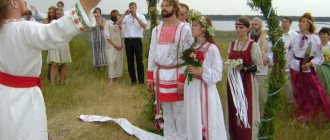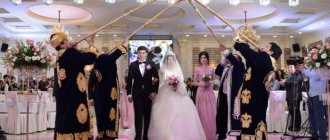A wedding is an exciting event for all participants, and a Slavic wedding or even just a wedding in the Slavic style can become an unforgettable, high celebration. Some customs of a Slavic wedding are known to everyone - for example, the wedding train, which used to be called a squad, or the presence of a loaf - a ritual cookie. A well-known ritual of a Slavic wedding is laying an embroidered Slavic towel on the ground, showering the newlyweds with hops and rye “for luck,” and a rich feast. And yet there are Slavic wedding traditions that need to be remembered and explained. This is discussed in the article.
Russian wedding tradition
At all times, the ceremony of marriage was divided into several parts, extended over time. Each stage required not only certain words and actions, but also other mandatory attributes - costumes, gifts, decoration of premises or vehicles.
The entire process took from one week to three months. Among the peasants, dates were arranged in accordance with the church and agricultural calendars. Not only relatives, but also friends of the bride and groom took part.
The central stage – the wedding – was particularly beautiful, solemn and splendid.
Bride ransom
Redemption is one of the Russian wedding rituals, which distinguishes the ritual of creating a new family in our country from celebrations in other countries. But it is worth noting that the process of ransoming the bride itself has changed a little: if previously it was carried out with the goal of getting the bride to leave her parents’ house, today it is arranged for the entertainment of guests.
Wedding ransom (art. K. Trutovsky)
Wedding price today
Previously, the ransom was carried out so that the groom could prove to everyone his worth and that he could support his family. That is, this custom was financial in nature.
One can also talk about collusion, which was popular in the last century. It took place after matchmaking and consisted of the distribution of expenses and gifts on both sides.
Wedding suits
An important role was played by the clothing of the participants in the ceremonies. The main colors are red and white. Red symbolized male strength and wealth, and white symbolized female purity, purity and beauty. Woven items were decorated with intricate embroidery with symbolic patterns.
It is interesting that in Ancient Rome and Medieval Europe only very rich people could afford red clothing. The dye was extracted from the shells of Mediterranean mollusks and was expensive. In Rus', red dye was made from carmine, a substance extracted from cochineal insects. Therefore, a Russian bride, even from the poor, could afford a chic outfit in a beautiful, dark red color.
Groom's outfit
If in Western countries the young man puts on a nondescript suit and gets lost in the motley crowd, then at a Russian wedding his clothes stand out from others. The main element is a red shirt or blouse. In the cold season, it could be replaced by a caftan of the same color. Often, not coarse cloth, but thin and elegant linen fabric was used to sew a suit. The groom's shirt was also decorated with embroidery, but in less quantity than the bride's. Most often, a thin layer of embroidered fabric covered only the collar. Rich people wore fur coats in winter.
The groom wore trousers or, as they said in Rus', trousers, often black, and boots on his feet. The lower part of a man's suit was not particularly important.
The groom's headdress is always a hat, regardless of the season. Furs have always been expensive and were a sign of wealth. Therefore, the groom could wear a fur hat decorated with velvet or pearls, even in summer. Ordinary people wore felt hats.
Bride's outfit
The young woman put sandals, bast shoes or woolen felt boots on her feet, depending on the season. Towards the beginning of the twentieth century, leather boots began to be often used.
Under her clothes, the bride wore a shirt made of homespun cloth. In those days, underwear did not yet exist; its functions were performed by this wardrobe item. Everyday shirts were simple and rough. Another thing is wedding. The bride began to decorate and embroider her outfits even before the wedding date was determined. The most commonly used threads were red and yellow.
A sundress was worn over the shirt - a dress with straps, not without sleeves. It could consist of several parts at once and usually had a wedge-like shape. Tailors in those days did not pay attention to women's waists; the narrowest part of the sundress was at the top, in the chest area. And the widest is near the ground. The color was almost always red, in rare cases - white or black with an abundance of multi-colored embroidery.
An apron was put on over the sundress, which served as a kind of “business card” of the bride. Girls spent years decorating it with embroidery. The entire costume was held together with one or more belts.
Separately, it is worth noting the newlywed’s headdress. In almost all regions of Russia, women wore kokoshniks. Only the shape or decorative elements could differ. According to tradition, the bride had to take off the kokoshnik only in front of her future husband, at the wedding ceremony. The priest placed crowns on the bowed heads of the newlyweds and began the ceremony. In different provinces, the kokoshnik was called magpie, kichka, and warriors. But the essence was always the same - a solid band and colorful fabric decorated with beads.
Bride kidnapping and slipper
If today bride kidnapping is only of an entertaining nature, then previously it was an event that did not seem funny to anyone. Before the wedding celebration, the bride could be kidnapped, and in this case her first wedding night should have taken place with a master or merchant.
Of course, the groom is unlikely to like this event, and he will resist! The bride was kidnapped and taken by force to the master. But if the groom was wealthy, then he could pay off such a theft procedure with money.
Bride kidnapping tradition
Bride's glass slipper
- Today, many people at weddings steal the bride’s shoe, although in the last century she herself had to give the shoe to her bridesmaids to try on. The girl whose shoe was the right size had to demand a ransom from the groom.
- Another tradition associated with the bride’s slipper occurs already in the midst of the holiday. The toastmaster asks the bride to take off her shoe and pours vodka into it to the very brim. The groom must drink the “witch’s potion”, and then all the troubles that can happen in the life of a young couple will be beyond his control!
Russian wedding ceremony in detail
Interestingly, many traditions have survived to this day. But, although their form remained almost the same, the essence has completely changed.
Matchmaking
If now matchmakers come to seek the consent of the young woman, then before they went for the father’s blessing. Usually it was not the groom’s parents who came, but his relatives or acquaintances who had the highest social status. The whole process could take place without the bride; her wishes were of little interest to the ceremony participants.
Typically, it was not customary to speak directly during matchmaking; indirect expressions were used. “You have a product, we have a merchant” or “You have a chicken, we have a rooster.” The matchmakers started the conversation from afar, because the young father had to refuse for the first time. Although in many cases, it was he who was most interested in marriage. Therefore, the ceremony was vaguely reminiscent of trade - the future father-in-law praised his daughter and dowry, and the matchmakers praised the groom and his family.
Bride
At the time of matchmaking, the issue of marriage had not yet been resolved positively. Therefore, the next stage is the bride's party, a visit of the bride's parents to the groom. According to the old Orthodox tradition, the husband took his wife to his home. Therefore, the father of the future newlywed went to look at the farm where his daughter would live and work.
Formally, it was during the viewing that the groom’s parents were able to look at the bride for the first time and communicate with her. In some regions, the wedding ceremony took place differently - the groom's parents went (after matchmaking) to the bride's parents.
In any case, it was at the bridesmaid ceremony that families made the final decision about marriage and the size of the dowry. For the bride, this day was the most important. It is clear that formally the decision was always made by the head of the family. But we know that the decision is often made by a woman, the future mother-in-law, instead of a man.
Betrothal in Russian tradition
(Bride's Blessing)
Engagement in the Orthodox world was very different from the Western one. Although our ancestors also used rings for weddings, this accessory did not play a dominant role. The most important thing was the official announcement of the consent of the fathers of each side and the announcement of the date. The parties seemed to enter into a “wedding agreement”, which was sealed by a public “handshake” - the fathers of the families shook hands. This is where the catchphrase “slap hands” comes from.
It is interesting that during the betrothal process not only the size of the “dowry” was finally approved, but also the size of the “treasure”. This word was used to describe guarantees of financial support for the bride from the groom's family. In the event that the future husband could not cope with his new responsibilities, the wife had to live off these funds for some time.
Preparation
(Preparing the bride for the wedding)
Further actions in the Russian wedding tradition varied greatly, depending on the era and region. In general, their essence boiled down to preparing a solemn wedding ceremony. The future bride wore different clothes than she told others about the upcoming event. Sometimes a bachelorette party was held, only the essence of it differed from modern festivities of a women's company. The young woman gathered unmarried girls to help her embroider wedding clothes and prepare a dowry.
The groom didn't mess around either. He needed to take care of the ransom, the wedding train and the place for the feast. And just before the wedding ceremony, the young man and his friends went to the bathhouse to cleanse themselves of all the sins of their bachelor life.
Matchmaking
A Russian folk wedding could not do without matchmaking. To do this, the groom's parents and himself had to come to the bride's house, so to speak, to make a match. In the last century, parents decided for their daughters who they could marry and who they could not marry.
Today, this tradition has almost been lost, since most marriages are made for love. And young people can choose for themselves with whom they will connect their lives. Parents can only accept the choice of their children. But still, the tradition of asking the betrothed’s father for her hand in marriage has been preserved; this is more a sign of respect than strict adherence to custom.
Just as before, today during matchmaking the groom must bring the bride an engagement ring, which should later be replaced by a wedding ring. If the groom came empty-handed, then he aroused distrust on the part of the bride’s parents.
Wedding
"Wedding Train"
In the old days, this term meant a cortege of horses and a cart on which the bride and groom rode to church. Only the poorest segments of the population had a walking wedding procession.
The harness of the horses was decorated with flowers and ribbons, the participants in the procession sang songs and wished health and prosperity to the newlyweds. The men participating on the groom's side wore red shirts or decorated their outfits with red belts and ribbons.
"Ransom" for the bride
In our Orthodox tradition, all sorts of rituals associated with the “purchase” of the bride or the groom’s right of way could take place at all stages of the wedding ceremony. In some villages, they even took a nominal fee from matchmakers who just came with an offer.
In most cases, the fee was symbolic or was charged in the form of performing some action. Sometimes the ransom could not be the bride herself, but some of her belongings or part of the wedding treats. This part of the ceremony has always been the most fun and interesting. Our ancestors also loved to play tricks on the groom, for example, by offering him another girl.
Church wedding
The most important sacrament in the entire wedding ritual. It was here that the bride became a wife and the groom became a husband. For the church wedding ceremony, the clergyman wore the most beautiful and formal clothes. Crowns, often in the shape of a crown, were placed on the heads of the newlyweds.
A number of ritual actions during the wedding symbolized the unity of the newlyweds. Their hands were tied with one towel or belt, they drank from the same cup or ate one piece of bread. In the north of Russia, it was customary to give young people one scarf, and they had to hold onto it and enter the church.
Only now the church wedding ceremony has acquired the same form throughout the country. In the old days, priests tried to follow the traditions of the area in which they served. They could cover the heads of the young with a cloth or “push their foreheads together.” Sometimes the young people walked around the altar and stood on one towel, scarf or belt. You will be surprised, but the tradition of closing the symbolic lock with a key after leaving the church and throwing it into the river has existed for several centuries.
Party and feast
Immediately after the completion of the ceremony, festivities began in the church. They usually took place in the groom's house. Due to the abundance of red in the clothes of the newlyweds, in some regions of Russia the traditional feast is also called the “red dinner”.
There could be several wedding tables at once. Guests were divided by gender, social status or family ties. In any case, the most important detail of the ceremony was the process of seating the guests. The young people seemed to indicate their attitude towards each of the guests. Here, for the first time, the newlyweds could sit down together at the table, in the place of honor, under the icons.
Rings
A wedding ceremony in Russia is not complete without the exchange of rings. This is an old tradition, without which it is difficult to imagine this holiday.
- You need to choose classic rings without stones and decorations, since, according to popular belief, all the irregularities on the ring are misfortunes that the newlyweds may encounter on their way. And due to the fact that the ring is round, these troubles will repeat again and again.
- Wedding rings that are passed down from generation to generation also need to be worn with great care. If your ancestors were happily married, then it will be a great honor for you to wear and carry through your life the relic of your parents, grandfathers and great-grandfathers.
- If someone from your family chain had misfortunes in marriage, or one of the spouses died a death other than natural, then it is better not to take on the energy of the rings of that married couple.
Wedding
Many couples still perform the sacrament of wedding today, but previously it was simply mandatory. This is how the newlyweds assure their relationship before God, and if they later have to separate, it is considered a great sin. Therefore, if you are not confident in your love, which you can carry for many years, then you should not get married and take sin on your soul.
In the last century, getting married at a Russian folk wedding was mandatory. The newlyweds spent a long time choosing the temple in which the wedding sacrament would take place, as well as their outfits.
Feast
The feast is one of the traditions of Russian weddings, which, first of all, spoke of the wealth of the parents of the bride and groom. There were no simple dishes on the festive table; each of them had a certain meaning and appeared on the table for a reason. The task of the young parents was to feed as many people as possible.
The following dishes must be present on the tables:
- Meat and fish dishes.
- Bread.
- Birthday cake.
- Vegetables.
Today, the feast is transferred to banquet halls where guests gather. And this table is prepared not by parents or even newlyweds, but by restaurant workers who receive money for it.
The wedding night
At the end of a Russian wedding, the main tradition must be observed - the first wedding night of the newlyweds. This is a very important event for the girl; the husband must carry the bride to the bed in his arms to protect her from demons.
- Often the first wedding night was spent in an unusual place so that the spirits could not find the newlyweds. The young people went to the hayloft, to the barn.
- Today, this tradition has been preserved, and many newlyweds spend their wedding night outside the home: in a hotel, country house, or rented apartment.
Rushnik
One of the main attributes of a Russian wedding can be considered a towel embroidered by the bride herself. This is part of the dowry that was given to the girl. The towel remained in the newlyweds’ house forever after the wedding.
Towels were used during weddings; there should have been two of them: the newlyweds stood on one, and their hands were tied with the second. Today, bread and salt are served to the young people on a towel.
The bride had to embroider not only a towel, but also the groom’s shirt on the eve of the holiday.
Bouquet and boutonniere
If we talk about Russian wedding traditions, many years ago the bride’s bouquet was made up by her betrothed. To do this, he could ask his neighbors for flowers growing in their gardens, and they could not refuse him. He could also pick flowers in the field.
The groom must give flowers to the bride after he has passed all the tests of the “ransom”. If the bride picks up a bouquet, this means that she agrees to connect her life with a man. After this, the bride must pin one of the flowers on the groom’s chest.
But today it is unlikely that the bride will allow her husband to buy a bouquet, since it must match her dress and the style of the celebration. But, according to traditions, the groom should not see the bride in a wedding dress before marriage.
The custom of throwing a bouquet into a crowd of unmarried girls came to Russia from Europe. But, as statistics show, such a sign does not come true so often. Previously, a round dance was gathered around the bride, and she, with her eyes closed, gave a bouquet to one of the bridesmaids.











